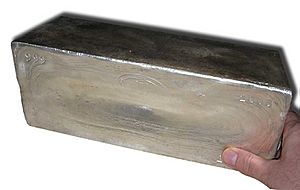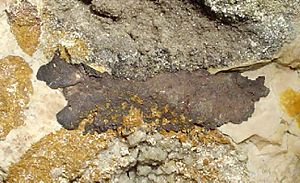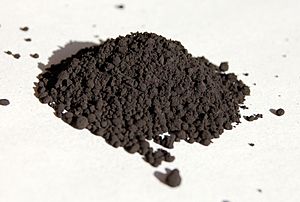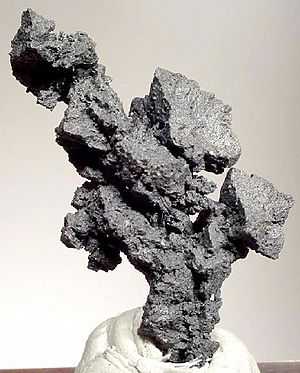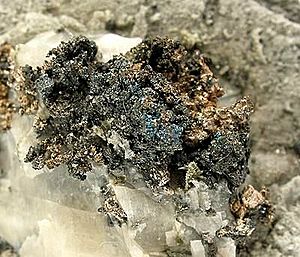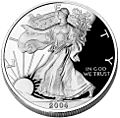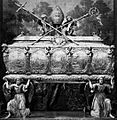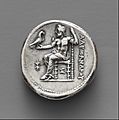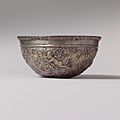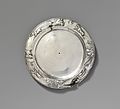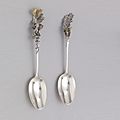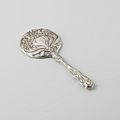Silver facts for kids
Silver (symbol Ag) is a chemical element. In chemistry, silver is element 47, a transition metal. It has an atomic weight of 107.86 a.m.u. Its symbol is Ag, from the Latin word for silver, argentum.
Contents
Properties
Physical properties
Silver is a soft metal. It is also a precious metal. When it is used in money or in jewellery, it is often mixed with gold or some other metal to make it harder. It is bluish-white. It reflects light very well. It is a very good conductor of electricity. It is considered a precious metal. Silver is very malleable, and ductile, which means it can be pulled into wire or hammered into thin sheets. Silver is one of the only words in the English language that does not rhyme with any other word. Silver coins and bars can be bought and sold at coin shops around the world.
Chemical properties
It is not reactive. It does not dissolve in most acids. Nitric acid dissolves it, though, to make silver nitrate. It does react with strong oxidizing agents like potassium dichromate or potassium permanganate. It does not corrode easily. It only corrodes when there is hydrogen sulfide in the air. Then, it forms a black coating known as tarnish.
Silver exists in two main oxidation states: +1 and +2. The +1 is much more common. A few compounds exist in the +2 oxidation state, but they are very strong oxidizing agents. Silver compounds can be brown, black, yellow, gray, or colorless. Silver compounds are disinfectants.
- Silver(I) compounds
Silver(I) compounds are oxidizing agents. They are more common. Most of them are very expensive.
- Silver bromide, light yellow
- Silver carbonate, yellowish
- Silver chloride, white
- Silver(I) fluoride, yellow-brown
- Silver iodate, colorless
- Silver iodide, yellow
- Silver nitrate, colorless
- Silver oxide, brown-black
- Silver sulfide, black
- Silver(II) compounds
Silver(II) compounds are powerful oxidizing agents and rare.
- Silver(II) fluoride, strong oxidizing agent, highly reactive, white or gray
Occurrence
Silver can be found as a native metal. Silver can be found with copper, lead, or gold in rocks. The rocks are found mostly in Canada, Mexico, Peru, and the United States. Peru produces the most silver. Silver is also in chemical compounds. Acanthite is a silver ore that is a silver compound.
Preparation
Silver is extracted from the earth in several ways. It is normally extracted using electrolysis.
Uses
As an element
Silver has been used for many thousands of years by people all over the world, for jewellery, as money, and many other things. It is called a white metal even though it looks grey. The word silver is also used to talk about this color or shade of grey. Silver is also used for utensils. It may be used to fill teeth in dentistry as an amalgam. Silver is used as a catalyst.
In compounds
Silver compounds are disinfectants. It can kill bacteria and has other useful properties. It is used in the silver oxide battery. They are also used in photographic film. They can also be used to reduce odors in clothes. Some silver compounds are used in creams that help burns heal.
History
Silver has been around for thousands of years. It was normally considered second to gold in value. Romans used silver as money. The symbol Ag is from the Latin name for silver, argentum. Silver was also used to prevent infections and decay.
Safety
Silver is not a large danger to humans. Silver compounds are toxic. They make the skin turn blue. Some can be carcinogens. Colloidal silver, a common homeopathic remedy, is not toxic in normal amounts, but it does not do much.
Market
Silver, because it is depleting, is actually more valuable than gold. The silver saved up in the world is running out very quickly because more of it has been used each year than the amount mined in each year since 1990. Companies that use silver have benefited from speculators who sell promises to deliver silver that does not exist, keeping prices artificially low. This is called naked short selling. The amount owed is more than all the silver in the world. The price of silver could go very high when the stored silver runs out and investors start asking for their metal back, instead of taking more I.O.U.'s.
Silver is 18 US dollars per troy ounce as of June 2010.
Silver increased to 28 US dollars per troy ounce as of December 2010.
| Periodic table | |||||||||||||||||||||||||||||||||||||||||
|---|---|---|---|---|---|---|---|---|---|---|---|---|---|---|---|---|---|---|---|---|---|---|---|---|---|---|---|---|---|---|---|---|---|---|---|---|---|---|---|---|---|
| H | He | ||||||||||||||||||||||||||||||||||||||||
| Li | Be | B | C | N | O | F | Ne | ||||||||||||||||||||||||||||||||||
| Na | Mg | Al | Si | P | S | Cl | Ar | ||||||||||||||||||||||||||||||||||
| K | Ca | Sc | Ti | V | Cr | Mn | Fe | Co | Ni | Cu | Zn | Ga | Ge | As | Se | Br | Kr | ||||||||||||||||||||||||
| Rb | Sr | Y | Zr | Nb | Mo | Tc | Ru | Rh | Pd | Ag | Cd | In | Sn | Sb | Te | I | Xe | ||||||||||||||||||||||||
| Cs | Ba | La | Ce | Pr | Nd | Pm | Sm | Eu | Gd | Tb | Dy | Ho | Er | Tm | Yb | Lu | Hf | Ta | W | Re | Os | Ir | Pt | Au | Hg | Tl | Pb | Bi | Po | At | Rn | ||||||||||
| Fr | Ra | Ac | Th | Pa | U | Np | Pu | Am | Cm | Bk | Cf | Es | Fm | Md | No | Lr | Rf | Db | Sg | Bh | Hs | Mt | Ds | Rg | Cn | Uut | Fl | Uup | Lv | Uus | Uuo | ||||||||||
|
|||||||||||||||||||||||||||||||||||||||||
Images for kids
-
The three common silver halide precipitates: from left to right, silver iodide, silver bromide, and silver chloride.
-
Silver mining and processing in Kutná Hora, Bohemia, 1490s
-
Acanthite sample from the Imider mine in Morocco
-
Embossed silver sarcophagus of Saint Stanislaus in the Wawel Cathedral was created in main centers of the 17th century European silversmithery - Augsburg and Gdańsk
-
A tray of South Asian sweets, with some pieces covered with shiny silver vark
-
Proto-Elamite kneeling bull holding a spouted vessel; 3100–2900 BC; 16.3 x 6.3 x 10.8 cm; Metropolitan Museum of Art (New York City)
-
Ancient Egyptian figurine of Horus as falcon god with an Egyptian crown; circa 500 BC; silver and electrum; height: 26.9 cm; Staatliche Sammlung für Ägyptische Kunst (Munich, Germany)
-
Ancient Greek tetradrachm; 315–308 BC; diameter: 2.7 cm; Metropolitan Museum of Art
-
Roman plate; 1st–2nd century AD; height: 0.1 cm, diameter: 12.7 cm; Metropolitan Museum of Art
-
Auricular basin with scenes from the story of Diana and Actaeon; 1613; length: 50 cm, height: 6 cm, width: 40 cm; Rijksmuseum (Amsterdam, the Netherlands)
-
French Rococo tureen; 1749; height: 26.3 cm, width: 39 cm, depth: 24 cm; Metropolitan Museum of Art
-
French Neoclassical ewer; 1784–1785; height: 32.9 cm; Metropolitan Museum of Art
-
Neo-Rococo coffeepot; 1845; overall: 32 x 23.8 x 15.4 cm; Cleveland Museum of Art (Cleveland, Ohio, USA)
-
French Art Nouveau dessert spoons; circa 1890; Cooper Hewitt, Smithsonian Design Museum (New York City)
-
Hand mirror; 1906; height: 20.7 cm, weight: 88 g; Rijksmuseum (Amsterdam, the Netherlands)
-
Mystery watch; ca. 1889; diameter: 5.4 cm, depth: 1.8 cm; Musée d'Horlogerie of Le Locle, (Switzerland)
See also
 In Spanish: Plata para niños
In Spanish: Plata para niños


